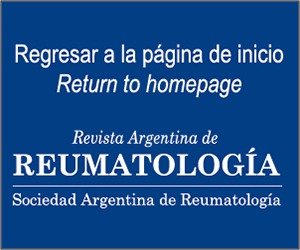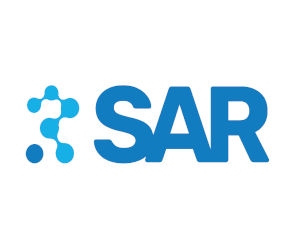Rendimiento del ASAS Health Index en pacientes con Espondiloartritis de la vida real
Resumen
Introducción: el cuestionario “Assessment of Spondyloarthritis International Society Health In- dex” (ASAS-HI) fue desarrollado para medir de manera global la funcionalidad y el estado de salud en pacientes con espondiloartritis (EspA). Se han propuesto puntos de corte para determinar diferentes estados de salud que fueron poco evaluados en pacientes de la vida real. Objetivos: describir el estado de salud medido por ASAS-HI en pacientes argentinos con EspA axial (EspAax) y periférica (EspAp) en la práctica diaria y evaluar los factores asociados al pobre estado de salud. Materiales y métodos: Estudio de corte transversal, analítico y multicéntrico. Se incluyeron consecutivamente pacientes con EspAax y EspAp según criterios ASAS, de 15 centros argentinos. Análisis estadístico: se realizó estadística descriptiva, análisis bivariado y multivariado (regresión logística múltiple) para evaluar los factores asociados al pobre estado de salud (ASAS-HI ≥12). Para analizar la validez de constructo de la herramienta se realizó correlación de Spearman entre el ASAS-HI y otros parámetros de evaluación de la enfermedad. Resultados: se incluyeron 274 pacientes con EspA, con una edad media de 49 (±14) años y una duración mediana de la enfermedad de 62 meses (p25-75: 24-135), 155 (56,6%) de los pacientes eran de sexo masculino, 129 pacientes (47%) con EspAax y 145 (52,9%) EspAp. Según el ASAS-HI 119 pacientes (43,4%) presentaban buen estado de salud, 117 (42,7%) tenían estado de salud moderado y 38 (13.9%) pobre estado de salud. En los pacientes con EspAp el valor de ASAS-HI mediano fue de 7 (p25-75: 3-10). El ASAS-HI correlacionó positivamente con: DAS28: rho: 0.5 (p<0.001) y HAQ: rho: 0.54 (p<0.001). La variable asociada de manera independiente con pobre estado de salud fue el DAS28 (OR: 1.9, IC95% 1.1- 3.4, p: 0.029). En los pacientes con EspAax el valor de ASAS-HI mediano fue de 6 (p25-75: 2.75-10). El ASAS-HI mostró correlación con: BASDAI: rho: 0.7 (p<0.001), ASDAS-ERS: rho: 0.7 (p<0,001), ASQoL: rho: 0.8 (p<0.001), BASFI rho: 0.75 (p<0.001). La variable que se asoció de manera independiente a pobre estado de salud fue el ASDAS-ERS (OR 6.6, IC95% 2-22, p 0.002). Conclusión: Un pobre estado de salud se asoció independientemente a mayor actividad de la enfermedad en pacientes con EspAax y EspAp. El ASAS-HI correlacionó con otros parámetros de la enfermedad, lo que refuerza la validez de constructo de esta nueva herramienta.Citas
I. Kiltz U, van der Heijde D, Boonen A, Cieza A, Stucki G, Khan MA, et al. Development of a health index in patients with ankylosing spondylitis (ASAS HI): final result of a global initiative based on the ICF guided by ASAS. Ann RheumDis. 2015;74(5):830-5.
II. Kiltz U, van der Heijde D, Boonen A, Akkoc N, Bautista-Molano W, Burgos-Vargas R, et al. Measurement properties of the ASAS Health Index: results of a global study in patients with axial and peripheral spondyloarthritis. Ann Rheum Dis. 2018;77(volumen):1311-7.
III. Rodrigues-Manica S, Cruz E, Ramiro S, Sousa S, Aguiar R, Sepriano A, et al. The European Portuguese version of the ASAS Health Index for Patients with Spondyloarthritis: Measurement properties. Acta Reumatol Port. 2020;45(1):26-33.
IV. KiltzU, Winter J, Schirmer M, Baraliakos X, Braun J. Validation of the German translation of the ASAS health index : A questionnaire to assess functioning and health in patients with spond-yloarthritis. Z Rheumatol. 2019;78(4):352-8.
V. Bautista-Molano W, Landewé RBM, Kiltz U, Valle-Oñate R, van der Heijde D. Validation and reliability of translation of the ASAS Health Index in a Colombian Spanish-speaking population with spondyloarthritis. ClinRheumatol. 2018;37(11):3063-8.
VI. Cruz EB, Ramiro S, Machado P, Sousa S, Aguiar R, Sepriano A, et al. Translation and cross-cultural adaptation of the ASAS Health Index and ASAS Environmental Factors Item Set into European Portuguese Language. Acta Reumatol Port. 2017;42(3):256-62.
VII. Kiltz U, van der Heijde D, Boonen A, Bautista-Molano W, Burgos-Vargas R, Chiowchanwisawakit P, et al. Measuring impairments of functioning and health in patients with axial spondyloarthritis by using the ASAS Health Index and the Environmental Item Set: translation and cross-cultural adaptation into 15 languages. RMD Open. 2016;2(2):e000311.
VIII. Choi JH, Kim TJ, Shin K, Choi CB, Kim JH, Kim SH, et al. The reliability and validity of a Korean translation of the ASAS Health Index and Environmental Factors in Korean patients with axial spondyloarthritis. J Korean Med Sci. 2014;29(3):334-7.
IX. Alonso-Castro S, Pardo E, Charca L, Pino M, Fernández S, Alperi M, et al. Performance of the ASAS Health Index for the Evaluation of Spondyloarthritis in Daily Practice. J Rheumatol. 2020;47(10):1483.
X. Akgul O, Bodur H, Ataman S, Yurdakul FG, Capkin E, Gurer G, et al. Clinical performance of ASAS Health Index in patients with ankylosing spondylitis and non-radiographic axial spondyloarthritis: real-world evidence from Multicenter Nationwide Registry. Rheumatol Int. 2020;40(11):1793-801.
XI. Min HK, Lee J, Ju JH, Park SH, Kwok SK. Predictors of Assessment of Spondyloarthritis International Society (ASAS) Health Index in Axial. Spondyloarthritis and Comparison of ASAS Health Index between Ankylosing Spondylitis and Nonradiographic Axial Spondyloarthritis: Data from the Catholic Axial Spondyloarthritis COhort (CASCO). J ClinMed. 2019;8(4):467.
XII. Duarte V, Kiltz U, Navarro-Compán V, Lloves N, Crespo Amaya G, Ferreyra L, et al. SAT0427 Asas healthindex: validity and reliability in Argentinean patients with spondyloarthritis Annals of the Rheumatic Diseases 2017;76:933.
XIII. Morante I, Aurrecoechea E, Villa I, Santos M, Riancho L, Queiro R. Construct validity of the ASAS health index in psoriatic arthritis: a cross-sectional analysis. Rheumatology (Oxford). 2021;60(3):1465-73.
XIV. Rudwaleit M, van der Heijde D, Landewé R, Listing J, Akkoc N, Brandt J, et al. The development of Assessment of SpondyloArthritis international Society classification criteria for axial spondyloarthritis (part II): validation and final selection. Ann Rheum Dis. 2009 Jun;68(6):777-83.
XV. Rudwaleit M, van der Heijde D, Landewé R, Akkoc N, Brandt J, Chou CT, et al. The Assessment of SpondyloArthritis International Society classification criteria for peripheral spondyloarthritis and for spondyloarthritis in general. Ann Rheum Dis. 2011 Jan;70(1):25-31.
XVI. Méndez Castellano, H Sociedad y Estratificación. Método Graffar-Méndez Castellano. Caracas: Fundacredesa; 1994.
XVII. Citera G, Arriola MS, Maldonado-Cocco JA, Rosemffet MG, Sánchez MM, Goñi MA, et al. Validation and crossculturaladaptation of anargentinespanishversion of thehealthassessmentquestionnairedisabilityindex. J ClinRheumatol. 2004 Jun;10(3):110-5.
XVIII. Mease PJ. Measures of psoriatic arthritis: Tender and Swollen Joint Assessment, Psoriasis Area and Severity Index (PASI), Nail Psoriasis Severity Index (NAPSI), Modified Nail Psoriasis Severity Index (mNAPSI), Mander/Newcastle Enthesitis Index (MEI), Leeds Enthesitis Index (LEI), Spondyloarthritis Research Consortium of Canada (SPARCC), Maastricht Ankylosing Spondylitis Enthesis Score (MASES), Leeds Dactylitis Index (LDI), Patient Global for Psoriatic Arthritis, Dermatology Life Quality Index (DLQI), Psoriatic Arthritis Quality of Life (PsAQOL), Functional Assessment of Chronic Illness Therapy-Fatigue (FACIT-F), Psoriatic Arthritis Response Criteria (PsARC), Psoriatic Arthritis Joint Activity Index (PsAJAI), Disease Activity in Psoriatic Arthritis (DAPSA), and Composite Psoriatic Disease Activity Index (CPDAI). Arthritis Care Res (Hoboken). 2011 Nov;63 Suppl 11:S64-85.
XIX. Prevoo ML, van ‘t Hof MA, Kuper HH, van Leeuwen MA, van de Putte LB, van Riel PL. Modified disease activity scores that include twenty-eight-joint counts. Development and validation in a prospective longitudinal study of patients with rheumatoid arthritis. Arthritis Rheum. 1995 Jan;38(1):44-8.
XX. Citera G, Maldonado Cocco JA, Moroldo M, Burgos-Vargas R, Anaya J, López I, et al. Validación de la versión en español de los cuestionarios de capacidad funcional BASFI y actividad de la enfermedad BASDAI en pacientes con Espondilitis Anquilosante en cuatro países latinoamericanos. RevArgReumatol 1999;10(1):25.
XXI. Doward L, Spoorerg A, Cook S. Development of the ASQoL: a quality of life instrument specific to Ankylosing Spondylitis. Ann Rheum Dis 2003;62(1):20-6.
XXII. Lukas C, Landewé R, Sieper J, Dougados M, Davis J, Braun J, et al. Development of an ASAS-endorsed disease activity score (ASDAS) in patients with ankylosing spondylitis. Ann Rheum Dis 2009;68(1):18-24.
XXIII. Koo TK, Li MY. A Guideline of Selecting and Reporting Intraclass Correlation Coefficients for Reliability Research. J Chiropr Med. 2016 Jun;15(2):155-63.
XXIV. Gorlier C, Orbai AM, Puyraimond-Zemmour D, Coates LC, Kiltz U, Leung YY, et al. Comparing patient-perceived and physician-perceived remission and low disease activity in psoriatic arthritis: an analysis of 410 patients from 14 countries. Ann Rheum Dis. 2019 Feb;78(2):201-208.
XXV. Studenic P, Radner H, Smolen JS, Aletaha D. Discrepancies between patients and physicians in their perceptions of rheumatoid arthritis disease activity. Arthritis Rheum. 2012 Sep;64(9):2814-23.
XXVI. Desthieux C, Granger B, Balanescu AR, Balint P, Braun J, Canete JD, et al. Determinants of Patient-Physician Discordance in Global Assessment in Psoriatic Arthritis: A Multicenter European Study. Arthritis Care Res (Hoboken). 2017;69(10):1606-11.
XXVII. Queiro R, Cañete JD, Montilla C, Abad MA, Montoro M, Gómez S, et al; MAAPS Study Group. Very Low Disease Activity, DAPSA Remission, and Impact of Disease in a Spanish Population with Psoriatic Arthritis. J Rheumatol. 2019 Jul;46(7):710-715.
XXVIII. Van Echteld I, Cieza A, Boonen A, Stucki G, Zochling J, Braun J, et al. Identification of the most common problems by patients with ankylosing spondylitis using the international classification of functioning, disability and health. J Rheumatol. 2006 Dec;33(12):2475-83.
XXIX. Schneeberger EE, Zamora N, Citera G. SASDAS (simplified version of ankylosing spondylitis disease activity score)-ESR performance and development of SASDAS-CRP and their agreement with ASDAS-ESR and ASDAS-CRP in patients with ankylosing spondylitis. ClinRheumatol. 2016;35(11):2865-6.
XXX. Aranda-Valera IC, Garrido-Castro JL, Ladehesa-Pineda L, Vazquez-Mellado J, Zarco P, Juanola X, et al. How to calculate the ASDAS based on C-reactive protein without individual questions from the BASDAI: the BASDAI-based ASDAS formula. Rheumatology (Oxford). 2020;59(7):1545-9.
XXXI. Kiltz U, Wendling D, Braun J. ASAS Health Index: The “All in One” for Spondyloarthritis Evaluation? J Rheumatol. 2020 Oct 1;47(10):1457-1460.
XXXII. Dougados M. Treat to target in axial spondyloarthritis: From its concept to its implementation. J Autoimmun. 2020 Jun;110:102398.
XXXIII. López-Medina C, Ramiro S, van der Heijde D, Sieper J, Dougados M, Molto A. Characteristics and burden of disease in patients with radiographic and non-radiographic axial Spondyloarthritis: a comparison by systematic literature review and meta-analysis. RMD Open. 2019 Nov 21;5(2):e001108.
XXXIV. López-Medina C, Molto A, Claudepierre P, Dougados M. Clinical manifestations, disease activity and disease burden of radiographic versus non-radiographic axial spondyloarthritis over 5 years of follow-up in the DESIR cohort. Ann Rheum Dis. 2020 Feb;79(2):209-216.
XXXV. Chen HH, Chen YM, Lai KL, Hsieh TY, Hung WT, Lin CT, et al. Gender difference in ASAS HI among patients with ankylosing spondylitis. PLoSOne. 2020;15(7):e0235678.
Derechos de autor 2021 A nombre de los autores. Derechos de reproducción: Sociedad Argentina de Reumatología

Esta obra está bajo licencia internacional Creative Commons Reconocimiento-NoComercial-SinObrasDerivadas 4.0.






